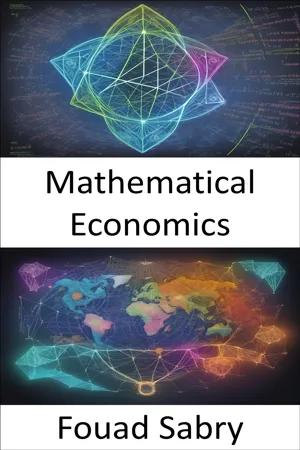
Mathematical Economics
Mastering Mathematical Economics, Navigating the Complexities of Economic Phenomena
- English
- ePUB (mobile friendly)
- Available on iOS & Android
Mathematical Economics
Mastering Mathematical Economics, Navigating the Complexities of Economic Phenomena
About this book
What is Mathematical Economics
Within the field of economics, mathematical economics refers to the utilization of mathematical techniques for the purpose of representing ideas and analyzing situations. It is common for these applied methods to go beyond simple geometry. Some examples of these approaches include differential and integral calculus, difference and differential equations, matrix algebra, mathematical programming, and other computer methods. The individuals who advocate for this method assert that it makes it possible to formulate theoretical linkages in a manner that is rigorous, general, and straightforward.
How you will benefit
(I) Insights, and validations about the following topics:
Chapter 1: Mathematical economics
Chapter 2: Navier-Stokes equations
Chapter 3: Riemann curvature tensor
Chapter 4: Fractional calculus
Chapter 5: Step response
Chapter 6: Drawdown (economics)
Chapter 7: KMS state
Chapter 8: Ramsey-Cass-Koopmans model
Chapter 9: Lattice Boltzmann methods
Chapter 10: Green's function (many-body theory)
Chapter 11: Stokes's law of sound attenuation
Chapter 12: Hasse-Davenport relation
Chapter 13: Discrete Morse theory
Chapter 14: Zonal spherical function
Chapter 15: Commutation theorem for traces
Chapter 16: Critical taper
Chapter 17: Moving load
Chapter 18: M/D/1 queue
Chapter 19: Katugampola fractional operators
Chapter 20: Functional differential equation
Chapter 21: Recharge oscillator
(II) Answering the public top questions about mathematical economics.
(III) Real world examples for the usage of mathematical economics in many fields.
(IV) Rich glossary featuring over 1200 terms to unlock a comprehensive understanding of mathematical economics. (eBook only).
Who will benefit
Professionals, undergraduate and graduate students, enthusiasts, hobbyists, and those who want to go beyond basic knowledge or information for any kind of mathematical economics.
Frequently asked questions
- Essential is ideal for learners and professionals who enjoy exploring a wide range of subjects. Access the Essential Library with 800,000+ trusted titles and best-sellers across business, personal growth, and the humanities. Includes unlimited reading time and Standard Read Aloud voice.
- Complete: Perfect for advanced learners and researchers needing full, unrestricted access. Unlock 1.4M+ books across hundreds of subjects, including academic and specialized titles. The Complete Plan also includes advanced features like Premium Read Aloud and Research Assistant.
Please note we cannot support devices running on iOS 13 and Android 7 or earlier. Learn more about using the app.
Information
Table of contents
- Chapter 1: Mathematical economics
- Chapter 2: Navier–Stokes equations
- Chapter 3: Riemann curvature tensor
- Chapter 4: Fractional calculus
- Chapter 5: Step response
- Chapter 6: Drawdown (economics)
- Chapter 7: KMS state
- Chapter 8: Ramsey–Cass–Koopmans model
- Chapter 9: Lattice Boltzmann methods
- Chapter 10: Green's function (many-body theory)
- Chapter 11: Stokes's law of sound attenuation
- Chapter 12: Hasse–Davenport relation
- Chapter 13: Discrete Morse theory
- Chapter 14: Zonal spherical function
- Chapter 15: Commutation theorem for traces
- Chapter 16: Critical taper
- Chapter 17: Moving load
- Chapter 18: M/D/1 queue
- Chapter 19: Katugampola fractional operators
- Chapter 20: Functional differential equation
- Chapter 21: Recharge oscillator
- Epilogue
- Appendix
- About the Author